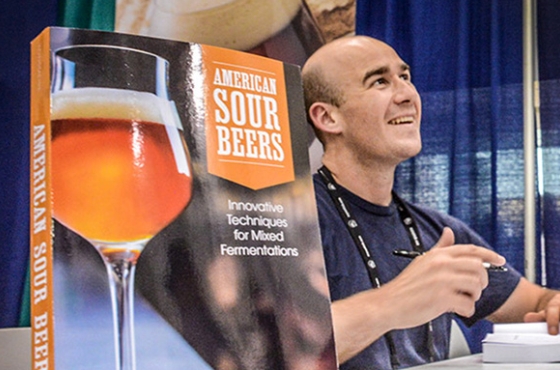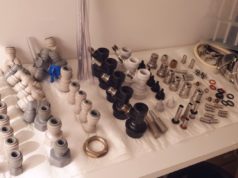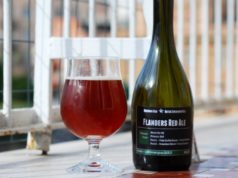Fino a qualche tempo fa le birre sour (acide) erano adorate e seguite da poche persone. Gli altri, la maggior parte dei bevitori, non le capivano e non le apprezzavano (me compreso, confesso). Nel corso degli ultimi anni, grazie alla diffusione sempre maggiore della consapevolezza birraria (ma anche grazie alla moda, diciamocelo) le birre acide sono entrate nelle grazie di una larga parte di bevitori. C’è ancora chi non le apprezza (legittimo, per carità), ma possiamo dire che la cerchia di chi le ama ha scavalcato i confini dell’elite di appassionati. Al punto che il famoso birrificio belga Cantillon ha dovuto ampliare lo spazio in cui tiene le botti allargandosi nella palazzina adiacente al vecchio birrificio. Altra notizia recente: quest’anno Cantillon non produrrà la Mamouche perché non ha abbastanza lambic a disposizione (la Mamouche è un lambic a cui vengono aggiunti fiori di sambuco).
Come accade sempre, molti homebrewer si sono chiesti: perché non provare a fare le birre acide anche a casa? Qualche pioniere ha iniziato molti anni fa, ma ultimamente questa pratica si è diffusa tantissimo tra gli homebrewer. In America, uno dei pionieri nella produzione delle birre acide in casa è Michael Tonsmeire, anche noto come The Mad Fermentationist. Con calma e pazienza ha iniziato a pubblicare i risultati delle sue sperimentazioni in un blog che con il tempo ha attirato l’attenzione di molti appassionati.
L’anno scorso il blog è diventato un bellissimo libro (ve lo consiglio, lo abbiamo recensito qui) e Michael è diventato praticamente una star. Nel futuro tradurremo qualche post dal suo blog, nel frattempo è stato così gentile da rispondere a qualche domanda. Qui sotto trovate l’intervista, nella versione italiana (prima) e poi anche nella versione originale in inglese.
(english version at bottom of page, click here)
Nel tuo libro affermi che le classiche buste della Wyeast da 100ml dovrebbero contenere 75 miliardi di cellule vive, almeno al momento del confezionamento. Come hai avuto questa informazione? Hai fatto un conteggio delle cellule?
Quel numero me lo ha dato direttamente qualcuno del laboratorio della Wyeast. Personalmente non ho mai fatto un conteggio delle cellule.
Un mio amico, che lavora in un laboratorio qui in Italia e studia i lieviti, ha fatto un conteggio sulle cellule vive presenti in una busta di Brettanomyces della Wyeast da 100ml: è uscito fuori un numero di cellule vive molto basso, intorno ai 5 miliardi. Detto che questo numero così basso potrebbe essere dovuto a una conservazione errata della busta o anche a un calo fisiologico (dipende dalla data di produzione), volevo farti una domanda: hai una qualche idea di come vari il tasso di vitalità nelle confezioni commerciali di Brettanomyces con il passare del tempo? E’ possibile fare in qualche modo una stima come facciamo solitamente con i Saccaromyces?
Sicuramente i Brett muoiono con il passare del tempo, anche in funzione del modo in cui la confezione viene conservata. Non sono però a conoscenza di alcun algoritmo che permetta di prevedere la perdità di viabilità di questi lieviti. Cellule di Brett sono state trovate ancora in vita in bottiglie vecchie più di trenta anni, quindi direi che sicuramente il tasso di autolisi è diverso e più lento rispetto ai Saccaromyces. Alcuni birrai hanno sperimentato una maggiore vitalità quando i Brett sono stati conservati a temperatura ambiente anziché a temperatura prossima allo zero. Sicuramente poi ci saranno differenze tra i vari ceppi di Brett.
Ci sono ormai diversi ceppi di Brettanomyces commercialmente disponibili per gli homebrewer (in Italia arrivano principalmente quelli della White Labs e della Wyeast). Qual è il tuo preferito e perché?
Dipende dalla birra. Dei ceppi commercializzati dalla Wyeast mi piace il classico Brettanomyces Bruxellensis (5112): un naso “funky” piacevole ma non eccessivo, si presta particolarmente bene per birre chiare e ben luppolate. Anche con il Brettanoomyces Lambicus (5526) ci si può divertire parecchio: molto fruttato, ricorda una torta di ciliege. Molto adatto per birre scure oppure per birre con ciliegie o frutta rossa in generale. Della White Labs mi piace molto il Brettanomyces Claussenii (WLP645): fruttato da giovane, con il tempo sviluppa un piacevole aroma di cuoio. Apprezzo molto anche il Saccaromyces “bruxellensis” Trois, anche se oramai è stato riclassificato da Brett a Saccaromyces selvaggio: produce comunque ottime birre fruttate se usato come unico lievito anche per la fermentazione primaria.
In generale a me piace molto inoculare i fondi delle bottiglie di birre acide commerciali (o anche fatte in casa) che amo particolarmente. Man mano che ho iniziato a entrare a regime nella produzione di lambic ho sviluppato qualche “coltura di lievito della casa” semplicemente reinoculando il fondo del fermentatore da una cotta alla successiva (a volte aggiungendo qualche altro microbo se necessario, per ottenere particolari profili aromatici).
Il problema principale della produzione di lambic in casa è la ripetibilità dei risultati. Tu come fai? Il segreto è nel blending?
Dato che non gestisco un birrificio, mi preoccupo poco della ripetibilità e della consistenza delle mie birre acide. Se hai un processo solido e una buona conoscenza dei microbi che stai utilizzando, produrrai buone birre acide nel 90% dei casi anche in casa, probabilmente tutte diverse tra loro. A me va bene anche così. L’attività di blending può essere interessante, ma non credo sia così importante come la maggior parte degli homebrewer crede. La ripetibilità è più importante ovviamente per i grandi birrifici, che devono fare in modo che i loro prodotti risultino consistenti e non perdano completamente identità tra una produzione e la successiva.
È ben noto che i fermentatori in plastica sono permeabili all’ossigeno che con il tempo stimola i Brettanomyces a produrre significative quantità di acido acetico. E’ ormai quasi un anno che il mio primo batch di lambic sta maturando in un fermentatore in plastica (ho inoculato B. Claussenii e Pediococcus) e ad oggi non ho ancora notato nessun tipo di acidità acetica. C’è da dire che non ho mai aperto il fermentatore dopo l’inoculo (prendo piccoli campioni dal rubinetto). Dico una cavolata totale se affermo che un fermentatore in plastica, se viene chiuso bene e non viene mai aperto (nemmeno per fare foto alla fermentazione!) può essere usato se l’invecchiamento non è troppo lungo (diciamo non più di un anno)?
La mia preoccupazione più grande con i fermentatori in plastica è la tenuta del coperchio. La plastica non è sufficientemente permeabile all’ossigeno per causare problemi entro un anno o anche due. Tuttavia, se il coperchio non è ben chiuso è facile che la birra diventi eccessivamente acetica nel giro di poco tempo. In questo senso, sicuramente i coperchi con la guarnizione sono migliori di quelli senza. A ogni modo, io userei al limite dei carboy di plastica chiusi con un tappo di gomma. Meno si apre il fermentatore, meglio è. Questo è particolarmente importante per fermentatori con una apertura ampia, in quanto una volta aperti lasciano passare molto più ossigeno rispetto ai carboy con apertura stretta.
Hai mai assaggiato birre sour prodotte in Italia? Puoi raccontarci cosa ne pensi?
Mi sono piaciute diverse birre sour prodotte in Italia. Negli US per molti anni è arrivata la Panil Barrique: mi piace anche più di alcune flanders red prodotte in Belgio, poiché è più acidica e maggiormente secca (ovviamente è un mio gusto personale). Nel mio libro [American Sour Beers, NdT] ho già menzionato il mio apprezzamento per la Beerbera di Loverbeer, una birra sour con mosto di vino particolarmente interessante. Ne ho assaggiate diverse altre, ma queste due sono quelle che mi sono rimaste particolarmente impresse.
Conosci il movimento degli homebrewer in Italia? Se sì, che idea te ne sei fatto?
Veramente non so molto del movimento degli homebrewers in Italia, ma data la vostra passione per il vino, il cibo e ora per la birra, immagino vada alla grande! L’ultima volta che sono stato in Italia avevo solo 15 anni, non ho avuto modo di entrare a contatto con il mondo birrario locale. Sono però da poco rientrato da un viaggio in Brasile e sono rimasto piacevolmente sorpreso da come la cultura della birra craft e dell’homeberwing si siano enormemente sviluppati negli ultimi anni. Sembra proprio che la passione per la buona birra si stia diffondendo velocemente in tutto il mondo!
Si sta ormai diffondendo in tutto il mondo la passione per le birre sour. Credi si tratti di una moda passeggera o di qualcosa di più duraturo? Se così fosse, temi una carenza di lambic per il futuro prossimo? (PS. io sì!)
In America abbiamo già una carenza di lambic. Quando, dieci anni fa, ho iniziato a bere birre acide, era facile trovare bottiglie di Cantillon, 3 Fonteinen, etc…. Persino le versioni speciali o quelle invecchiate erano piuttosto disponibili. Sono passati diversi anni da quando ho visto qui in America l’ultima bottiglia di Cantillon (quella classica) e quando l’ho vista il prezzo era raddoppiato o anche triplicato rispetto a quanto le pagavo anni fa. Speriamo che con il maggior interesse a livello mondiale per le birre acide aumentino anche le produzioni locali, per poter venire incontro alla richiesta. Personalmente spero che l’interesse per le birre acide continui ad aumentare, ma sarebbe un vero peccato se i migliori produttori al mondo, quelli storici, non riuscissero più a star dietro alla domanda.
ENGLISH VERSION
In your book you state that the classic Wyeast 100 ml package should have roughly 75 billion live Brett cells (at least at the time of packaging). How did you get this information? Did you do any cell count?
The information was directly from someone in the lab at Wyeast. I didn’t do a cell count personally.
A friend of o mine, who works in a yeast lab here in Italy, ran a cell count on a Brett Lambicus Wyeast 100ml package and got a viability of 5 billions cells. This drop could be blamed on mishandling of the package during storage or simply natural viability loss over time. The question is: do you have any idea how the viability of the Brett packages evolves over time? Can we make an estimation of sort based on the manufacturing date like we normally do with the Saccharomyces strains?
Brett certainly dies over time, and that would be influenced by the storage conditions. I’m not aware of an algorithm to estimate the death rate though. Brett has been found alive in 30-year-old bottles of beer, so I’d suspect the autolysis rate would be lower than for Saccharomyces, but I have no hard data to support that. There are some brewers who see better activity storing Brett at room temperature than near-freezing. There is likely big strain-to-strain variability as well.
There are a few strains of Brettanomyces available to homebrewers (in Italy we mostly got Wyeast and White Labs strains). Which is your favourite and why?
It depends on the beer. Of the Wyeast strains, I really like the classic Brettanomyces bruxellensis 5112. Nice funky nose without being overwhelming, melds well with pale and hoppy beers especially well. Brettanomyces lambicus 5526 is a fun strain too, very cherry-pie fruity. Nice in darker beers, or with cherries or berries. From White Labs, I like WLP645 Brettanomyces claussenii, fruity young and leathery with age. I also like the former WLP644 Saccharomyces “bruxellensis” Trois. Even though it is now understood to be a wild Saccharomyces and not a Brett, it makes some beautifully fruity beer during primary fermentation.
In general I’m a big fan of pitching bottle dregs from commercial beers (or homebrews) you enjoy. As I’ve brewed more sours I’ve started to develop a few house cultures simply by repitching the same yeast from batch-to-batch (adding more microbes as the flavor requests).
The main problem with lambic brewing at home is getting repeatable results. How do you manage that? It’s all in the blending?
As I’m not a commercial brewery, I don’t worry too much about consistency and repeatability. If you have a good process and know what microbes you enjoy, you’ll produce good sour beer 90% of the time, it just won’t always taste the same. I’m OK with that. Blending can be fun, but I don’t think it is as necessary as some homebrewers make it sound. Commercial breweries have to be more concerned with their beers tasting the same each release.
We all know that plastic buckets are somewhat permeable to oxygen which stimulates production of acetic acid by Brett strains. I have been aging my first batch of lambic (pitched with Brett Claussenii and Pediococcus) in a plastic bucket and after a year it doesn’t seem to have developed any acetic flavour at all. I never (ever) opened the bucket during this long time (I took small samples from the tap). Am I completely wrong if I say that if you keep the lid well closed (and resist the urge to take fermentation pictures) the plastic bucket could be acceptable to age sour beers? (if you age the beer for not too long, say a year).
My bigger concern is the fitting of the lid itself. The plastic is not permeable enough to cause major issues within a year or two. However, if the lid isn’t snapped on perfectly, you can get a very acetic result in not much time. The lids with gaskets seem more reliable than the snap-on type, but for me the risk is more than I want. I’d rather use a plastic carboy with a stopper. The less you open any fermentor the better, but it is especially important for buckets because of the wide opening and the increased risk of a poor seal.
Had you ever had the chance to taste some sour beer from Italy? If so, can you tell us something about your tasting experience?
I’ve enjoyed several sour beers I’ve tried from Italy. We’ve gotten Panil Barriquée here for many years. I like it as much or more than the classic Belgian reds. It is drier and more acidic than many of the Flemish examples, my preference. Side Note: Not sure if it is still the case, but we were getting an unsweetened version of it here that I believe wasn’t available in Italy. I also mentioned my fondness for LoverBeer BeerBera in the book, a fun wine-heavy tart beer. I’ve tried some others as well, but those are the two that really stand out.
What idea do you have (if any) of the Italian homebrewing scene?
I really don’t know much about homebrewing in Italy, but given the passion for food, wine, and now beer I’d expect that it’s exciting! I was last in Italy when I was 15, so I didn’t observe much of the brewing culture first hand. I recently returned from Brazil and was impressed by how their craft and homebrewing scenes have developed. It seems like much of the world is gaining interest in good beer!
People all over the world are getting really mad about lambic. Do you think this is a transitory fashion or something that will stick for a while? If so, are you afraid of any lambic shortage in the near future? (PS. I am!).
We already have a bit of a lambic shortage in America. When I started drinking sour beer 10 years ago it was easy to find Cantillon, 3 Fonteinen etc. even the more limited releases, and bottles of a few years old were always on the shelf. It’s been a few years since I saw a single bottle of Cantillon Classic, and when I do the price is double or triple what it was back then. Hopefully as sour brewers around the world improve, there will be more interest in local sour beer. I hope interest in sour beer continues to grow, but it would be sad if production at the best producers does not match.






Bello Francè! hai fatto un buon lavoro
Grazie Lorenzo!